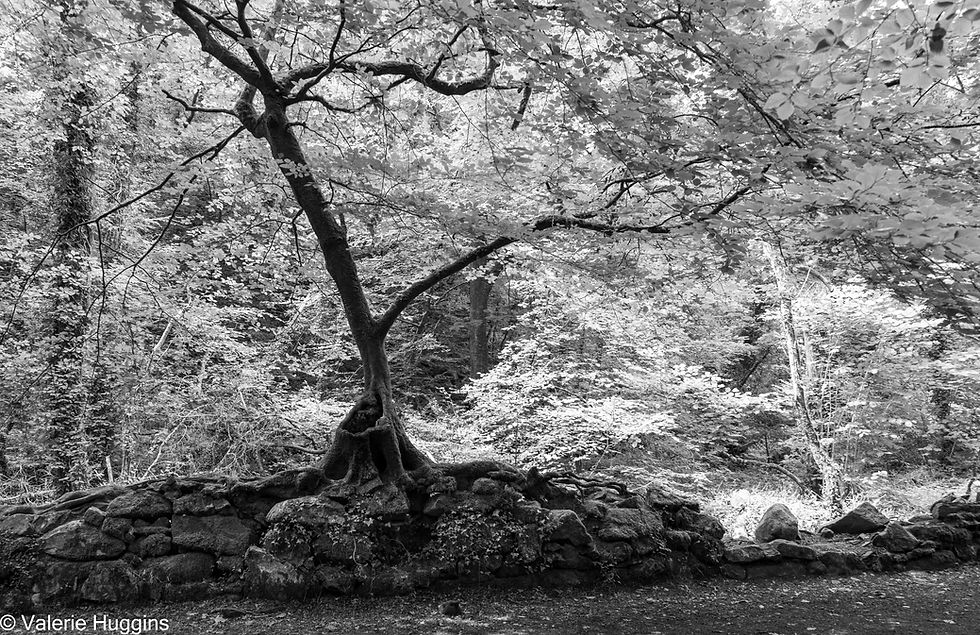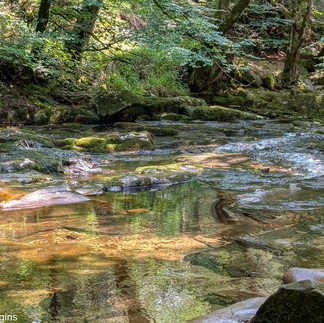Exploring stillness and change: Black and White in the Woodland
- valeriehuggins0
- Aug 11
- 5 min read

I’m really enjoying my year-long photography course with Charlotte Bellamy. Each month, Charlie sets us a new creative challenge to interpret in our own way. I’ve found this blend of structure and freedom incredibly inspiring. With each passing month, the challenges build on one another, and I notice myself carrying forward ideas, techniques, and a deeper way of seeing.
This month’s theme for the Woodland Challenge focuses on black and white photography, a format I’ve only dabbled in before. Black and white is, of course, where photography began. The work of pioneers like Ansel Adams and Florence Henri is now rightly considered fine art. I remember standing in front of Dorothea Lange's iconic 'Migrant Mother' (1936), struck by the raw emotion it conveyed. Stripped of colour, it spoke with a power and immediacy that was unforgettable.

Black and white photography is still widely used today, especially in genres like fashion, street and architectural photography. Photographers such as Sebastião Salgado choose it deliberately to highlight the world’s beauty in a more universal, timeless way. In a review of Genesis, his monumental work, one writer notes:
“Salgado’s habitual monochrome runs all the way from coal black to silver and burning white, with a thousand tones of grey in between... Black and white puts everything on equal footing, on the same planet.”
It’s a humbling thought—what big shoes to fill. But it reminds me why black and white photography can be so transformative. It strips away distraction, narrowing our focus to three key elements: the subject, the light, and the background. This simplification often heightens the emotional impact and pushes us to see differently—and more deeply.
After a bit of technical experimentation, I figured out how to shoot in Monochrome mode on my camera. Inspired by the minimalist and meditative approach of photographer Paul Sanders, I also chose to work in a square format—another constraint that helped sharpen my eye.

For this challenge, I explored a new location: Longtimber Woods in Ivybridge, a 53-acre working woodland and nature reserve nestled in the River Erme valley. With alder, ash, beech, hazel, sycamore, and willow lining its paths, the wood is a rich tapestry of textures and tones. The River Erme, which rises on Dartmoor and rushes through Ivybridge to the sea at Mothecombe, carves through the woodland in a fast, lively current, tumbling over granite boulders in a series of waterfalls—both visually and sonically dramatic, and perfect for monochrome.
One of the first things that caught my eye was the towering granite piers of a viaduct, partly obscured by branches. I soon learned they were the remains of a Grade II listed railway bridge, originally designed by Brunel and opened in 1848. It was later replaced in 1894 during the conversion to dual gauge. I’ve travelled that very railway line countless times without ever realising the story hidden in the woods below.
Through the monochrome viewfinder, the colours vanished, and new qualities emerged—shape, texture, contrast. The stone arches framed by trees, the shimmer of water over rock, the lace-like tangle of bare branches—all came into sharper relief. In such a visually complex environment, the absence of colour became a gift, removing the noise and revealing form and feeling with greater clarity. The trunks of the trees become statues with the adornment of the delicate leaves:
In summer the colours in the woodland are so vibrant and joyful, I compared the monochrome and colour as I often rely on colour contrasts or a splash of colour to give my photos a 'pop'. Which do you prefer in this set?
I also had a play with looking for abstract patterns in the environment around me, spending time watching the river and her interaction with the rocks and the reflections of the trees on her bank. The monochrome emphasised lines and shapes, creating intriguing images:
ICM in black and white was a new experience, which I know I need to practise more to get the effects that are possible. . The lack of colour possibly adds pathos to the scene, but I do miss the glorious summer greens!
These two images convey two different impressions of the river, and I now appreciate more the choices that I can make as a photographer in shaping the viewer's response:
As I wandered along this Dartmoor river I was reminded of the work of John Curno (1949–2020), a photographer whose black and white images—particularly of Dartmoor—have deeply inspired me. I first discovered his work at a workshop last year and now own two of his books. His final trilogy—Dartmoor: Lanes and Crosses (2015), Dartmoor Lifelines (2018), and Dartmoor: The Final Peace (2020)—was created while he was undergoing cancer treatment towards the end of his life.
In that last book, Curno reflects:
“Some of my photographs looked like some of the scans (x-ray, MRI, ultrasound); so subconsciously, instead of recording my impression of the landscape, I was occasionally imposing myself on it. We are all part of nature—we should treat it with more respect, as if it is our own bodies.”
His words linger with me. They’ve made me more mindful of where I point my lens, what I choose to notice—or overlook. A twisted branch, a weathered rock—these can evoke people we’ve known, moments we’ve lived.
Curno found beauty not only in the pristine, but in the broken, the scarred, the enduring. Few landscapes remain untouched by human presence, but Curno’s images reveal the quiet power of natural forces over time. As writer Eugénie Shinkle notes:
"The landscape of the moors was created by ice, water, and weather—etching granite, moving earth, carving out valleys and tors… Alongside this millennial flow is a different cadence that remakes the landscape continually—measured in small daily increments... These slow unfoldings are registered in Curno's photographs, which reveal an enduring respect for place and a slower, more measured way of seeing.”
That idea of slow change feels especially resonant now, in a world so marked by acceleration and disorientation. Greta Thunberg’s call for “cathedral thinking” comes to mind:
“We must lay the foundation while we may not know exactly how to build the ceiling.”
Rebecca Solnit builds on this idea, noting that addressing the climate crisis is not about finding a single, sweeping solution—but about committing to long, patient work:
“All I had was slow—the story of a journey with many steps, gradual shifts, accumulating knowledge, concern, and commitment... A lot had happened, but it had happened in many increments over a few decades, not via one transformative anything.”
Standing in Longtimber Woods, looking up at an ancient tree—likely unchanged in my lifetime—I was reminded that change often happens imperceptibly.

But that doesn’t mean it isn’t happening. As science writer David Hambling warns:
“The increasing number of extreme climate events… has not raised awareness of the threats posed by climate change. Instead, people change their idea of what they see as normal.”
We live in changing times—but then again, we always have. Watching Human by Ella El-Shamahi reminds me of this, as does Stephen Harding’s Deep Time Walk: a 4.6 km journey through Earth’s 4.6 billion-year history. Humanity appears only in the final 20 cm of that walk. A sobering reminder of our fleeting presence—and our outsized impact.
On a visit to RAMM in Exeter yesterday with a dear friend, it was a joy to see some of John Curno's photographs featured in the new exhibition "Wild" which explores our relationship with the natural world and how people around the world are rebuilding and re-imagining that connection. A timely and hopeful note to end on.
Sit back and enjoy these short videos of beautiful monochrome images from Ivars Skudra and Olga Karlovac.



























































Comments